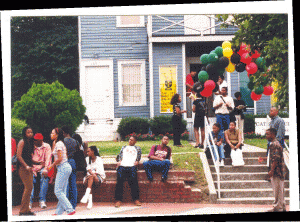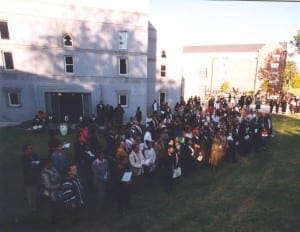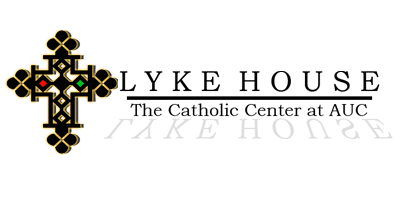
The Catholic students who gathered at Morehouse College in 1950 were eager to secure the space to celebrate Catholic Mass on their campus. The students assigned the task to Benjamin Gibson, who was appointed spokesperson for the group. Gibson presented his classmates’ request to Fr. Michael J. McKeever of the Immaculate Conception Church. On June 11, 1951, Bishop Gerald Patrick Aloysius O’Hara of the Diocese of Savannah-Atlanta granted Fr. McKeever’s request on behalf of the students. In September of the same year, the students began celebrating mass in Danforth Chapel on the campus of Morehouse College. This marked the beginning of the Newman Ministry among the Atlanta University Center.
In support of the students’ commitment, equally committed faculty members in the Atlanta University Center volunteered their time and resources to nurture this new ministry. During this time, the Newman ministry in the AUC benefited greatly from the caring and loving leadership of Dr. Harding Young, the Dean of the School of Business at Atlanta University (now known as Clark Atlanta University), and his wife Sadie Young, a member of the Spelman College faculty.
In recognition of the interest of the faculty, staff, and students within this community, the Archdiocese of Atlanta enlisted the aid of religious congregations and orders of priests to provide the initial part-time and eventual full-time personnel for this ministry in the AUC. Among those who heeded the call for assistance were the Congregation of Passion, the Franciscan Friars of the Holy Name Province, the Southern Province of the Holy Cross Fathers, and Fr. Edward Howard of the Society of Jesus. It was during Fr. Howard’s four-year tenure that a house for the Newman ministry was purchased on Raymond St., thus marking the beginning of a new era in the Atlanta University Center.
In 1976, the Archdiocese appointed St. Anthony’s Church to oversee the growing ministry in the AUC. The late Fr. William Calhoun, formerly of St. Anthony’s, took the lead role and served as the first African American priest of the Archdiocese. Following Fr. Calhoun’s departure for the military, Fr. John Adamski led the Newman ministry for four years. Following his term, Fr. Joseph Cavallo led the ministry for five years.
A few years later at the request of the students from Clark Atlanta University (CAU), Morehouse College, and Spelman College, Fr. Bruce Wilkinson, the first African American pastor of St. Anthony’s, invited Mrs. Tamell Alexander to assist with the ministry. Upon hearing these same students’ request, Archbishop Eugene Marino asked Fr. John Harfman of the Society of St. Joseph to launch a feasibility study of the AUC ministry. Results of the study concluded that there was a dire need for a full-time priest and a permanent facility in the AUC for the Newman ministry. Archbishop Marino then asked Fr. Edward Branch of the Archdiocese of Louisville, Kentucky to consider taking on a new challenge in Atlanta. Following his doctoral study at Howard University in Washington, D.C., Fr. Branch relocated to seize the task of leading and advancing the growth of the Catholic ministry in the AUC. With Archbishop James P. Lyke shepherding the diocese, Fr. Branch, a former campus minister, gave an even greater impetus for development.
On November 9, 1990, Fr. Branch arrived in Atlanta and met an enthusiastic group of eager students. These students were: Consuello “Buffie” Campbell, Peter Clark, Allesandra Ennet, Kevin McKinney, Faldinia Nicole Simmons, Shelita Knight, Martin Turner, Patrick Turner, and Keidra Taylor. Since then and for more that fourteen years, the Lyke House Catholic Center at the AUC has undergone tremendous growth and has played an integral role in the holistic development of students within the AUC collegiate community.
Our First Home
There was a little blue house on James P. Brawley Dr., which served as the first Catholic center. It was leased to the Archdiocese of Atlanta by Clark Atlanta University, and for six years, it housed an average of four Rudd Residents per year. These students, the very first Ministry Assistants, were named after Daniel Rudd, a black Catholic activist of the 1900s. Rudd published the very first African American Catholic newspaper, the Black Catholic Tribune, and together with others, launched a African American Catholic Congress Movement called The Federation of Colored Catholics.
Dedication of the New Lyke House

With the support of a number of generous volunteers from the local community, Fr. Branch worked diligently to position the Lyke House Catholic Center for service in the year 2000 and beyond. In particular, the dedication and volunteer time of the members of the Building Design Committee opened new doors of opportunity for the Catholic center. The unrequited commitment of Mr. Alan Pinado and the help of Mr. LaDarrion Steinback, who gathered parcels of land for the new site, had been and will always be invaluable.
A special note in the history of the Lyke House Catholic Center at the AUC: due to the willingness of Ms. Elain Jordan Kirby Terrel to sell her family home at 809 Beckwith Street, the construction of the new facility was made possible. It is also noteworthy to mention that this house was built by her parents, Mr. Shepherd Jordan, Jr., and Mrs. Louise Connally Jordan.
Archbishop James P. Lyke

The new Lyke House Catholic Center was named after the beloved Archbishop James Patterson Lyke of the Archdiocese of Atlanta. Serving in many capacities, including auxiliary bishop, apostolic administrator, vicar, pastor, teacher, and Newman Organization director, Archbishop Lyke was dedicated to the Catholic liturgy, and to bringing to fruition this same liturgy among the Catholic students of the AUC. Archbishop Lyke, who served as the fourth archbishop of the archdiocese of Atlanta, and was at one time the highest-ranking black bishop in the U.S. Catholic Church, played a major part in the development of a Catholic center in the AUC, and if not for his efforts and the efforts of his predecessor, Archbishop Eugene A. Marino, there would be no Lyke House today. Archbishop Lyke passed away on December 27th, 1992, but the students and the faculty of the Lyke House will forever reflect his legacy and the warmth of his spirit.
